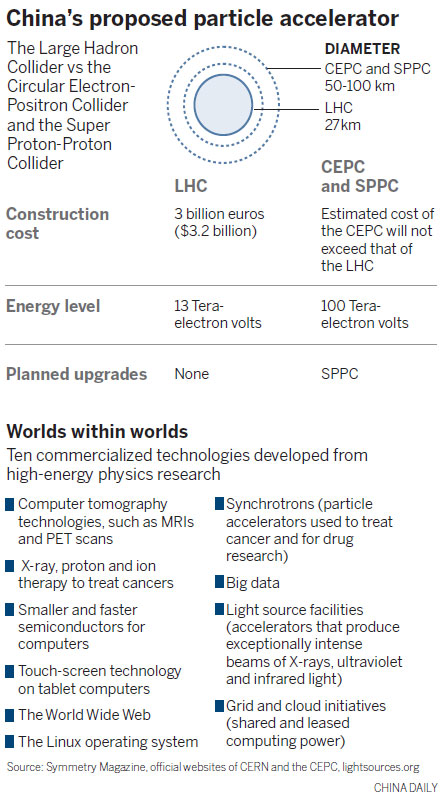|
|
Beneficial spinoffs
So, why would any government spend billions dollars of taxpayers' money on these "big toys" for particle physicists? To satisfy natural curiosity about the origins of the universe or simply to win a few Nobel Prizes?
Those are both credible reasons, but the reality is that the resultant "secondary products" of high-energy research are the driving force.
"In high-energy physics research, there is no existing equipment or methods for us to explore particles about which we know little, so we design and build the equipment ourselves from scratch," Wang said.
That process has resulted in the development of many technologies that have subsequently been applied in wider fields. The World Wide Web is a prime example; in 1989, Tim Berners-Lee, a British scientist working at CERN, invented the Web to facilitate automatic information sharing between CERN scientists in different countries. A few years later, CERN made the software publicly available, thus allowing the growth and development of the Internet.
In China, the construction of the BEPC improved the country's industrial technology and resulted in microwave components and devices that can be applied to radar systems.
Heidi Schellman from Northwestern University in the US, uses the metaphor of climbing Qomolangma, known in the West as Mount Everest, to illustrate the case; the fact that a person is climbing the mountain will not directly affect anyone's daily life, but the fleece jackets and breathable waterproof fabrics that were first invented for serious mountaineering expeditions are now relatively cheap, indispensable and ubiquitous.
Leadership transfer
Despite the short- and long-term benefits that huge scientific projects can bring, the cost of building a super collider is so huge that the world can only afford one at a time.
In the late 1970s, roughly at the same time as the LHC, the US launched an ambitious project in Texas; an 87-km-long collider called the Superconducting Super Collider. However, the project came under fire from the beginning when critics railed against the budget of more than $4 billion.
In 1993, a nonprofit watchdog called the Project on Government Oversight, released a draft audit report that heavily criticized the high cost and poor management, leading the US Congress to officially cancel the SSC in October 1993, even though $2 billion had already been spent.
"The cancellation of the SSC was a disaster for high-energy physics in the US. Overnight, we ceded leadership of a field we had pioneered and driven for decades to Europe," said Arkani-Hamed, who added that the ramifications of the decision continue to be felt.
"Some physicists cynically thought the money for the SSC would go to their favorite areas, but of course nothing of the sort happened. Instead, after the cancellation of the SSC, the US ceased to think of itself as a place where 'really big things can happen'. It has made many of our scientists timid and small-minded in their thinking about the future," he said.
That unfulfilled dream has been adopted by new candidates. CERN is considering a project similar to China's, while Japan is planning an International Linear Collider, which would require more-advanced technology and a much larger budget.
Wang, from the Institute of High Energy Physics, said no matter how fierce the competition, the high cost means there is only likely to be one 100 TeV (trillion electron volts) collider in the world at any given time.
"In the end, it will come down to whose design is best," he said.
Arkani-Hamed believes China can build and operate a massive collider project. "No matter where such a machine happens, developing and building it is going to require a huge influx of new people into the field. China has an ocean of the necessary raw talent needed to make this happen," he said, citing the country's growing economic power and its desire to improve the basic level of research as prime factors.
"There is no other field where leadership can be transferred so decisively, because here the major facility is a discrete unit (a separate entity that's part of a larger whole) and scientists around the world will follow the machine wherever it is," he said.
Contact the writer at chengyingqi@chinadaily.com.cn

(
